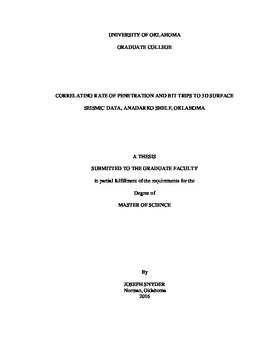| dc.description.abstract | While initially thought to be laterally homogeneous, operators quickly realized that unconventional resource plays can exhibit considerable geologic heterogeneity. Since this realization, 3D surface seismic analysis has played a significant role in identifying drilling hazards and sweet spots. Much less effort, however, has been invested in mapping the heterogeneity of the drilling process itself, where some zones drill faster, some slower, and still others result in costly casing trips to change the bit. Given the current low oil price, there is an increased need for efficiency and cost reduction in the drilling process. A method to better predict drilling speed could make a significant impact.
In this thesis, I correlate the rate of penetration to surface seismic measurements made over the heterogeneous Mississippi Lime resource play in Woods County, Oklahoma. 50 horizontal wells with mud logs measuring the rate of penetration (ROP) in minutes/foot fall within a 70 mi2 seismic survey. Exploratory data analysis shows that geomechanical attributes of P-impedance, inverted-porosity, λρ and µρ and the geometric attribute curvedness have good correlations with ROP. I then evaluate a Proximal Support Vector Machine (PSVM) and an Artificial Neural Network (ANN) to predict classifications of the speed of drilling – or cost of penetration in minutes per foot – for lateral segments of the wells. Because the objective is to develop a technique to reduce the cost of drilling, I weighted each well segment by the time it took to drill, and then defined discriminant boundaries between classes defined as equally weighted percentiles. I initially attempted to assign 40 of the wells, irrespective of driller, into 5-class and 2-class PSVM and ANN models, but obtained poor validation with the 10 wells not used in the training. Hypothesizing that a given directional drilling company will follow consistent, if not rigid, company specific operating protocols, I used these smaller data sets to generate three 2-class (fast and slow) PSVM and ANN models. I obtained increased validation of 2-class PSVM of 17-32%; however, the results for the ANN were weaker with a decrease in validation for some cases. More specifically, the 2-class PSVM correctness increased from 57% for the entire data set to 85%, 70% and 70% when the data were separated by the three directional drillers. The 2-class ANN correctness changed from 66% for the entire data set to 73%, 64% and 66% when the data were separated by directional driller.
In an effort to further lower drilling costs, I correlate bit trips in the lateral segments of wells to Gray Level Co-Occurrence Matrix (GLCM) texture attributes. Using eight GLCM attributes – contrast, correlation, dissimilarity, energy, entropy, homogeneity, mean and variance – and building off the knowledge that the directional driller had an effect on the results of the PSVM, I was able to obtain strong correctness for a 2-class (high number of bit trips and low number of bit trips) PSVM model. The 2-class PSVM correctness obtained ranged between 90-93%. | en_US |
